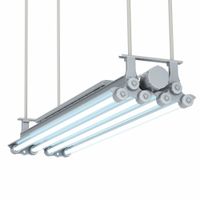- Home
- Lighting
- Lighting Fixtures Retrofit Kits
- Hazardous Location Lighting Fixtures
Hazardous Location Lighting Fixtures
Hazardous location lighting fixtures illuminate areas with flammable, combustible, or ignitable materials. Also known as hazloc lights, they keep arcs and sparks contained so that the fixtures won't cause a fire or explosion. They carry class and division ratings as defined by NEC and OSHA for use i .....Read More
Frequently Asked Questions
What are hazardous location lighting fixtures?
What are the class and division ratings for hazloc lights?
How do hazardous location lights prevent fires and explosions?
What are the differences between Class I and Class II fixtures?
What types of fixtures are available for hazardous locations?
How do retrofit kits benefit hazardous location lighting?
What are the group ratings for hazardous location lighting fixtures?



